 |
New York Architecture Images- Lower Manhattan
BANK OF NEW YORK |
|
|
architect |
Voorhees, Gmelin & Walker | |
|
location |
One Wall Street, at Broadway | |
|
date |
1931 | |
|
style |
Art Deco | |
|
construction |
limestone | |
|
type |
Bank | |
 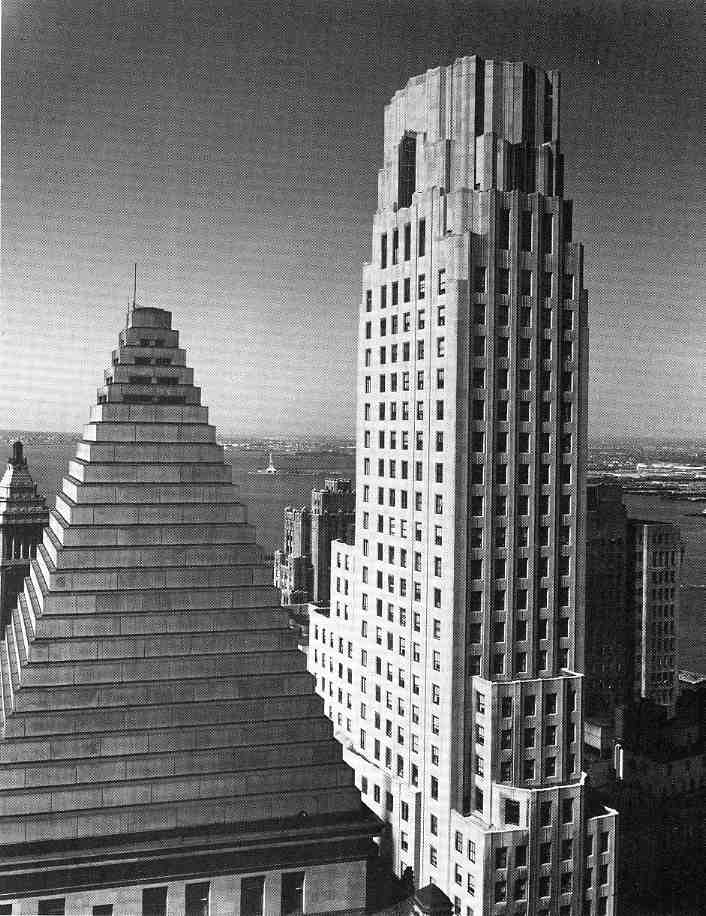 |
||
 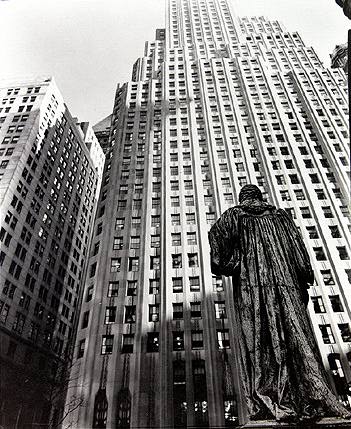 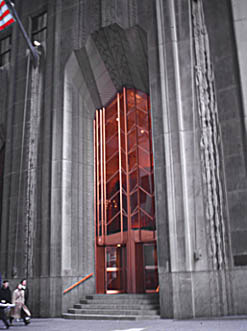 |
||
|
images |
  |
|
|
|
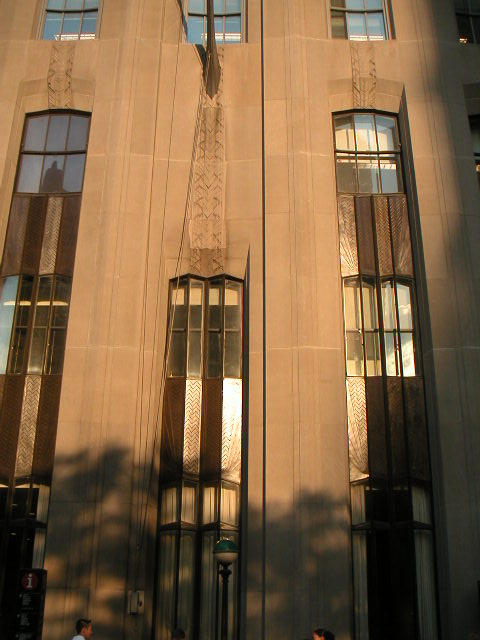  |
|
  |
||
 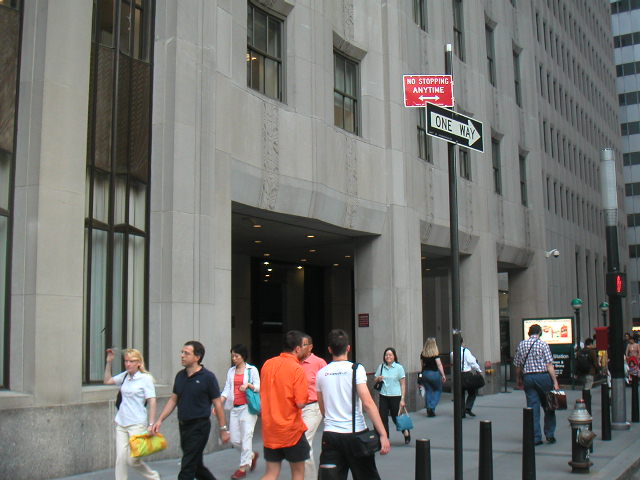 |
||
      |
||
  |
||
| In contrast to the American Surety Building, where height is minimized by the subdivision of its facade, the design of the Irving Trust building has an insistent verticality which emphasizes its tall form. This set back skyscraper is modeled as if it was chiselled out of a single piece of stone and it is a good example of the Art Deco style popular in the U.S. in the 1920s and 1930s. The building's pointed windows echo the Gothic details of Trinity Church across the street, and its Art Deco interior is one of the finest in New York City. | ||
|
notes |
Interior details of the Red Room in the Irving Trust Company Building
showing the mosaics by Hildreth Meiere. 
|
|
|
Constructed in 1929-31 as the corporate
headquarters of the Irving Trust Company, this 50-story, limestone-faced
skyscraper is situated on what was considered the “most expensive real
estate in New York,” the intersection of Wall Street and Broadway. The
prestigious location became the site of this extraordinary Art Deco
tower designed by the noted architect Ralph T. Walker of the firm of
Voorhees, Gmelin & Walker. The Irving Trust Company had been founded as
the Irving Bank in 1851 in New York's Washington Market area to serve
the needs of local merchants and food distributors. It then evolved
through a series of mergers and acquisitions that began in 1907 when the
Irving Bank merged with the New York Exchange Bank. By 1928, the bank
had outgrown its impressive quarters in the Woolworth Building and was
planning its own building on Wall Street. Ralph Walker, the architect
chosen for the new facility, was well-known for his distinctive designs
of buildings for the telephone and telegraph industries. In his work,
Walker attempted to express the possibilities of modern machine
technology in order to create buildings that would be suggestive of the
modern period. At 1 Wall Street, he employed a smooth limestone skin
arranged in a series of undulating surfaces to simulate a fluted column,
or the effect of draped material hanging from the sky, varying the
rhythm of the curves throughout the building. Subtle setbacks lead to a
narrow tower enhanced by large window openings near the top. The
faceted, chamfered corners and pointed tops of the fluted bays create a
crystalline effect at the crown of the building. The lower stories are
accentuated by narrow window openings with decorative mullions, shallow
incised designs, and theatrically-inspired entranceways. Throughout this
century the bank continued to expand, culminating in the 1988
acquisition of the Irving by The Bank of New York, which created today's
modern, international financial institution.
Special thanks to www.nyc.gov |
||
|
The Bank of New York: A History of Distinction The Bank of New York’s history of providing distinguished service spans three centuries. We are proud of our heritage -- to have had our beginnings at the birth of a new republic and to have had our history inexorably woven into the broader history of the nation that we grew up with and prospered with along the way. The Bank’s history began on February 23, 1784, with a small advertisement featured in The New York Packet,
A meeting was held the next evening at which prominent New York citizens launched The Bank of New York. Alexander Hamilton, a highly respected New York attorney and future statesman, was enlisted to write the new Bank’s constitution and became the individual most actively involved in the organization of The Bank of New York, guiding it through its early stages, and leaving a lasting imprint on its philosophy and operation throughout its history. The First Of A Kind  The
Bank of New York, New York’s first bank, was opened for business at the
Walton House in Lower Manhattan on June 9, 1784, only a few months after
the departure of British troops from American soil. The fledgling
nation was looking for economic credibility during a time when its
monetary system was complex and confusing. The “gentlemen” who met in
response to the notice in the Packet constituted New York
City’s top merchants and lawyers, men of property and influence, who had
joined together in a common cause. They each subscribed a portion of
their wealth to form a bank. While it was the first bank in the City of
New York, this Bank was all the more notable because it was capitalized
not on land, as was the custom, but on specie – money in coin. The
Bank of New York, New York’s first bank, was opened for business at the
Walton House in Lower Manhattan on June 9, 1784, only a few months after
the departure of British troops from American soil. The fledgling
nation was looking for economic credibility during a time when its
monetary system was complex and confusing. The “gentlemen” who met in
response to the notice in the Packet constituted New York
City’s top merchants and lawyers, men of property and influence, who had
joined together in a common cause. They each subscribed a portion of
their wealth to form a bank. While it was the first bank in the City of
New York, this Bank was all the more notable because it was capitalized
not on land, as was the custom, but on specie – money in coin.In post-Revolutionary America, hard money was scarce. The situation was aggravated by the collapse of the bills of credit issued by the Continental Congress and the individual states, which resulted in making specie the only acceptable legal tender. Specie were foreign coins in gold and silver which were commonly accepted as dependable commodities because of their sound basis in Europe and extensive use in maritime commerce. By insisting that their Bank should be paid up in “specie only,” the founders of The Bank of New York responded to depositors’ concerns about the safety of a bank that circulated a quantity of paper disproportionate to its holdings. They decided that their practice would be to have a sufficient amount of metal at all times to preserve the circulation of notes in ratios of one dollar in specie to two or more dollars in notes. They also decided to make only short-term loans generally between one and two months and to only do business with merchants and manufacturers who were sound, steady, and conservative. With this strong fiscal policy and rapid turnover of capital, the Bank was able to produce assets that constantly generated specie. This sound, basic foundation would keep the Bank on solid financial footing throughout its history. Alexander Hamilton As Secretary of the Treasury in George Washington’s first cabinet, Alexander Hamilton negotiated the first loan obtained by the new government in 1789. The amount was $200,000 issued by The Bank of New York, against which the Treasury drew a series of warrants on the Bank. These warrants were a milestone in establishing the credit of the United States government and the economic independence of the young nation. Hamilton’s economic vision and firm grasp of banking principles served The Bank of New York well. Right from the start, the Bank began paying dividends and, except for a one-year moratorium mandated by the government, has continued to do so uninterrupted for more than two centuries. The Early Years 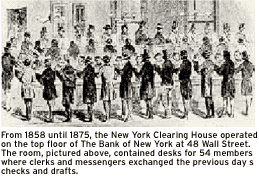 The
Bank immediately became the financial heart of the city. With the mutual
benefit of serving, at the time, as the capital of both the state and
the nation, New York was flourishing. For the next 15 years, The Bank
of New York stood alone as the generator of virtually all of the city’s
commercial activity. Importers of cargoes entering the port of New York
turned to the Bank for financing. The
Bank immediately became the financial heart of the city. With the mutual
benefit of serving, at the time, as the capital of both the state and
the nation, New York was flourishing. For the next 15 years, The Bank
of New York stood alone as the generator of virtually all of the city’s
commercial activity. Importers of cargoes entering the port of New York
turned to the Bank for financing. In 1792, the New York Stock Exchange was formed and the first corporate stock to be traded was The Bank of New York. Also in that year, the Bank loaned money to the Society for Establishing Useful Manufactures to assist in carrying out plans for building factories in Paterson, New Jersey. The loan was the beginning of the Bank’s support of economic growth in the New York metropolitan area. The Bank was also closely involved with the growth of transportation. The construction of the Morris Canal in New Jersey and the Erie Canal in New York was partially funded by the Bank, which also provided financing to the steamboat companies that benefited from these waterways. Trust powers granted to the Bank in the 1830s gave us new areas in which to grow and enabled us to build the fine reputation we have had in trust and investment management for close to 200 years. The beginning of the new industrial age coincided with the Bank’s centennial in 1884. Through investments in nearly every railroad and utility, as well as in the construction of the New York City subway system, The Bank of New York continued to provide vital capital to the expanding American economy. However, far more emphasis was given to conservative practices and retaining the confidence of its customers. That policy enabled the Bank to survive the economic turmoil of the early twentieth century. The 20th Century  Shortly
after the end of World War I, it became obvious that in an expanding
economy, a larger capital structure was needed to serve the commercial
needs of the Bank’s customers and to further protect its rapidly growing
deposits. In July 1922, The Bank of New York and the New York Life
Insurance and Trust Company merged. In addition to increasing the
Bank’s capital structure, the merger brought with it an established and
important trust business. Shortly
after the end of World War I, it became obvious that in an expanding
economy, a larger capital structure was needed to serve the commercial
needs of the Bank’s customers and to further protect its rapidly growing
deposits. In July 1922, The Bank of New York and the New York Life
Insurance and Trust Company merged. In addition to increasing the
Bank’s capital structure, the merger brought with it an established and
important trust business.Through the next decade, the wise management and sound judgment of the Bank’s executives enabled it to emerge from the stock market crash and ensuing economic depression not only unharmed but with its official staff strengthened, its deposits increased, and its field of activities materially enlarged. The Bank’s management continued to provide strong leadership through the coming years. Following the mergers with the New York Life Insurance & Trust Company, The Fifth Avenue Bank in 1948, and the Empire Trust Company in 1966, the Bank expanded its presence in New York and its ability to provide financial services to businesses and individuals throughout Manhattan. In 1969, through the establishment of a bank holding company, the Bank expanded beyond the borders of New York City. The acquisitions of National Community Banks in New Jersey and The Putnam Trust Company in Connecticut in the 1990s continued the expansion of a branch network that remains one of the largest in the New York metropolitan area. Global expansion began with an office in London in 1966 and led to the creation of a network of branches, representative offices, affiliates and operations centers through which the Bank would be able to support clients located or invested in any corner of the world. The next major breakthrough occurred in 1988 with the acquisition of The Irving Bank Corporation. This transaction, involving two highly complementary institutions, created the tenth largest bank in the United States at that time and set the stage for The Bank of New York today. The Bank Of New York At The Beginning Of The 21st Century The Bank of New York entered the twenty-first century as a premier provider of the essential services that enable institutions and individuals to move and manage their financial assets. Our preeminent position in our chosen business space reflects a corporate vision centered on being the acknowledged global leader, our clients’ preferred partner and a catalyst for change – for the betterment of our clients and our industry. We are investing in support of our vision, as evidenced by the May 2003 acquisition of Pershing LLC, a leading global provider of correspondent clearing and outsourcing solutions for broker-dealers, asset managers and financial intermediaries. This pivotal deal was one of more than 80 acquisitions we completed in a ten-year span. Together with ongoing internal product development, these acquisitions have enabled us to stay in front of our clients’ evolving needs and extend the already broad range of services we offer in securities management, treasury management, asset management, and private and retail banking. In the process, we have solidified our reputation as a global leader and an industry pioneer, and become a more valuable partner to our clients. A History Of Distinction 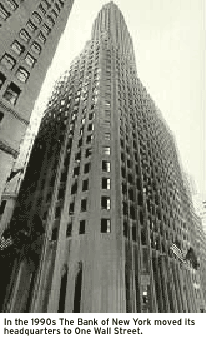 Since
its inception, The Bank of New York has been vitally important in
building the economic leadership of the United States. Today, the Bank
plays a critical role on a larger stage by providing the products and
services that help support capital markets activity globally. Since
its inception, The Bank of New York has been vitally important in
building the economic leadership of the United States. Today, the Bank
plays a critical role on a larger stage by providing the products and
services that help support capital markets activity globally.During the course of its 220-year history, The Bank of New York has seen its home country through turbulent times – seven wars, ten economic depressions and the World Trade Center disaster. And yet, the Bank has survived all these crises and emerged stronger for them, owed to an allegiance to a set of shared and enduring values – Excellence, Teamwork, Personal Responsibility, Respect and Integrity – and an unwavering focus on the needs of our clients. As a result, The Bank of New York is well positioned to help our clients succeed in the world’s rapidly evolving financial markets. |
||
| http://www.bankofny.com/index.htm | ||